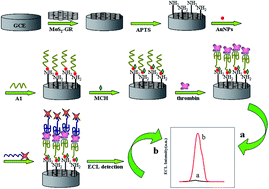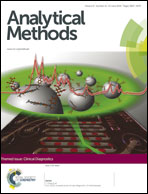A novel sandwich electrochemiluminescence aptasensor based on molybdenum disulfide nanosheet–graphene composites and Au nanoparticles for signal amplification
Abstract
In this work, we constructed a novel sandwich electrochemiluminescence (ECL) aptasensor for sensitive detection of thrombin based on molybdenum disulfide nanosheet–graphene (MoS2–GR) composites and Au nanoparticles. In the protocol, MoS2–GR composites were firstly synthesized and assembled on the glassy carbon electrode (GCE) to promote electron transfer. Subsequently, gold nanoparticles (AuNPs) were covered on the electrode to improve the immobilized amount of aptamer1 (Apt1) that could further amplify the ECL signal as well. Afterwards, Apt1 was conjugated to the electrode via Au–S bonds. Finally, the target thrombin and the quantum dot labeled aptamer2 (QD-Apt2) as signal probes were successively attached to the GCE to fabricate a sandwich ECL aptasensor. With the excellent features of the MoS2–GR composites, AuNPs, and sandwich structures, multiple signal amplification for the ECL aptasensor has been achieved. The ECL intensity depended linearly on the logarithm of the thrombin concentration in the range from 0.02 to 5.0 pM with a detection limit of 1.3 fM (S/N = 3). Furthermore, the aptasensor was successfully applied to the determination of thrombin in human plasma with the recoveries of 90.0–102.4% and the RSDs of 2.1–3.7%. The protocol could serve as a new tool for protein detection in biochemical analysis.


 Please wait while we load your content...
Please wait while we load your content...